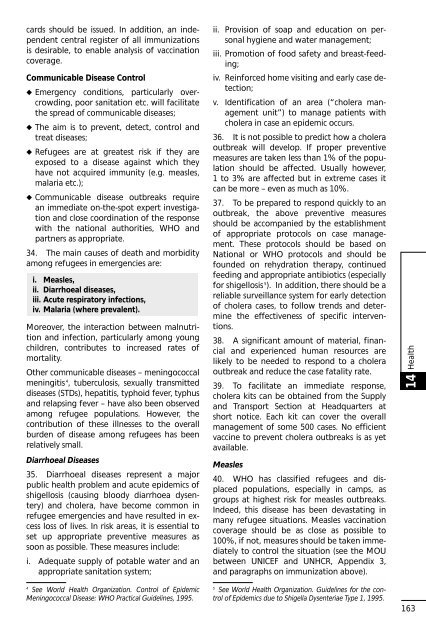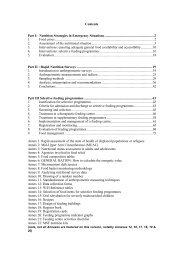UNHCR Handbook for Emergencies - UNHCR eCentre
UNHCR Handbook for Emergencies - UNHCR eCentre
UNHCR Handbook for Emergencies - UNHCR eCentre
Create successful ePaper yourself
Turn your PDF publications into a flip-book with our unique Google optimized e-Paper software.
cards should be issued. In addition, an independent<br />
central register of all immunizations<br />
is desirable, to enable analysis of vaccination<br />
coverage.<br />
Communicable Disease Control<br />
◆ Emergency conditions, particularly overcrowding,<br />
poor sanitation etc. will facilitate<br />
the spread of communicable diseases;<br />
◆ The aim is to prevent, detect, control and<br />
treat diseases;<br />
◆ Refugees are at greatest risk if they are<br />
exposed to a disease against which they<br />
have not acquired immunity (e.g. measles,<br />
malaria etc.);<br />
◆ Communicable disease outbreaks require<br />
an immediate on-the-spot expert investigation<br />
and close coordination of the response<br />
with the national authorities, WHO and<br />
partners as appropriate.<br />
34. The main causes of death and morbidity<br />
among refugees in emergencies are:<br />
i. Measles,<br />
ii. Diarrhoeal diseases,<br />
iii. Acute respiratory infections,<br />
iv. Malaria (where prevalent).<br />
Moreover, the interaction between malnutrition<br />
and infection, particularly among young<br />
children, contributes to increased rates of<br />
mortality.<br />
Other communicable diseases – meningococcal<br />
meningitis 4 , tuberculosis, sexually transmitted<br />
diseases (STDs), hepatitis, typhoid fever, typhus<br />
and relapsing fever – have also been observed<br />
among refugee populations. However, the<br />
contribution of these illnesses to the overall<br />
burden of disease among refugees has been<br />
relatively small.<br />
Diarrhoeal Diseases<br />
35. Diarrhoeal diseases represent a major<br />
public health problem and acute epidemics of<br />
shigellosis (causing bloody diarrhoea dysentery)<br />
and cholera, have become common in<br />
refugee emergencies and have resulted in excess<br />
loss of lives. In risk areas, it is essential to<br />
set up appropriate preventive measures as<br />
soon as possible. These measures include:<br />
i. Adequate supply of potable water and an<br />
appropriate sanitation system;<br />
4 See World Health Organization. Control of Epidemic<br />
Meningococcal Disease: WHO Practical Guidelines, 1995.<br />
ii. Provision of soap and education on personal<br />
hygiene and water management;<br />
iii. Promotion of food safety and breast-feeding;<br />
iv. Rein<strong>for</strong>ced home visiting and early case detection;<br />
v. Identification of an area (“cholera management<br />
unit”) to manage patients with<br />
cholera in case an epidemic occurs.<br />
36. It is not possible to predict how a cholera<br />
outbreak will develop. If proper preventive<br />
measures are taken less than 1% of the population<br />
should be affected. Usually however,<br />
1 to 3% are affected but in extreme cases it<br />
can be more – even as much as 10%.<br />
37. To be prepared to respond quickly to an<br />
outbreak, the above preventive measures<br />
should be accompanied by the establishment<br />
of appropriate protocols on case management.<br />
These protocols should be based on<br />
National or WHO protocols and should be<br />
founded on rehydration therapy, continued<br />
feeding and appropriate antibiotics (especially<br />
<strong>for</strong> shigellosis 5 ). In addition, there should be a<br />
reliable surveillance system <strong>for</strong> early detection<br />
of cholera cases, to follow trends and determine<br />
the effectiveness of specific interventions.<br />
38. A significant amount of material, financial<br />
and experienced human resources are<br />
likely to be needed to respond to a cholera<br />
outbreak and reduce the case fatality rate.<br />
39. To facilitate an immediate response,<br />
cholera kits can be obtained from the Supply<br />
and Transport Section at Headquarters at<br />
short notice. Each kit can cover the overall<br />
management of some 500 cases. No efficient<br />
vaccine to prevent cholera outbreaks is as yet<br />
available.<br />
Measles<br />
40. WHO has classified refugees and displaced<br />
populations, especially in camps, as<br />
groups at highest risk <strong>for</strong> measles outbreaks.<br />
Indeed, this disease has been devastating in<br />
many refugee situations. Measles vaccination<br />
coverage should be as close as possible to<br />
100%, if not, measures should be taken immediately<br />
to control the situation (see the MOU<br />
between UNICEF and <strong>UNHCR</strong>, Appendix 3,<br />
and paragraphs on immunization above).<br />
5 See World Health Organization. Guidelines <strong>for</strong> the control<br />
of Epidemics due to Shigella Dysenteriae Type 1, 1995.<br />
Health<br />
14<br />
163



